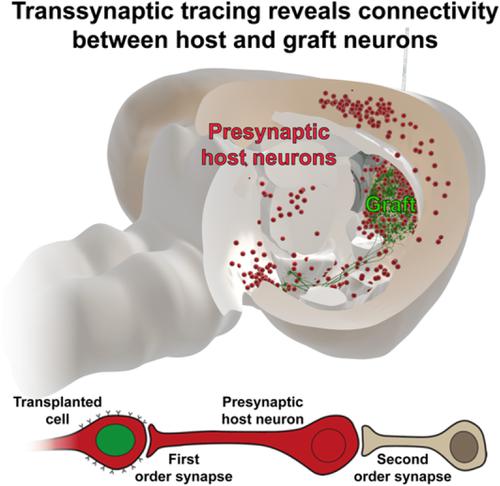当前位置:
X-MOL 学术
›
STEM CELLS
›
论文详情
Our official English website, www.x-mol.net, welcomes your
feedback! (Note: you will need to create a separate account there.)
Transsynaptic tracing and its emerging use to assess graft-reconstructed neural circuits
STEM CELLS ( IF 4.0 ) Pub Date : 2020-03-05 , DOI: 10.1002/stem.3166 Andrew F Adler 1, 2 , Anders Björklund 1 , Malin Parmar 1, 2
STEM CELLS ( IF 4.0 ) Pub Date : 2020-03-05 , DOI: 10.1002/stem.3166 Andrew F Adler 1, 2 , Anders Björklund 1 , Malin Parmar 1, 2
Affiliation

|
Fetal neural progenitor grafts have been evaluated in preclinical animal models of spinal cord injury and Parkinson's disease for decades, but the initial reliance on primary tissue as a cell source limited the scale of their clinical translatability. With the development of robust methods to differentiate human pluripotent stem cells to specific neural subtypes, cell replacement therapy holds renewed promise to treat a variety of neurodegenerative diseases and injuries at scale. As these cell sources are evaluated in preclinical models, new transsynaptic tracing methods are making it possible to study the connectivity between host and graft neurons with greater speed and detail than was previously possible. To date, these studies have revealed that widespread, long‐lasting, and anatomically appropriate synaptic contacts are established between host and graft neurons, as well as new aspects of host‐graft connectivity which may be relevant to clinical cell replacement therapy. It is not yet clear, however, whether the synaptic connectivity between graft and host neurons is as cell‐type specific as it is in the endogenous nervous system, or whether that connectivity is responsible for the functional efficacy of cell replacement therapy. Here, we review evidence suggesting that the new contacts established between host and graft neurons may indeed be cell‐type specific, and how transsynaptic tracing can be used in the future to further elucidate the mechanisms of graft‐mediated functional recovery in spinal cord injury and Parkinson's disease.
中文翻译:

跨突触追踪及其在评估移植物重建神经回路中的新兴用途
几十年来,胎儿神经祖细胞移植物已在脊髓损伤和帕金森病的临床前动物模型中进行了评估,但最初对原代组织作为细胞来源的依赖限制了其临床可转化性的规模。随着将人类多能干细胞分化为特定神经亚型的稳健方法的发展,细胞替代疗法有望大规模治疗各种神经退行性疾病和损伤。由于在临床前模型中对这些细胞来源进行了评估,因此新的跨突触追踪方法使得以比以前更快的速度和细节研究宿主和移植神经元之间的连接成为可能。迄今为止,这些研究表明,广泛、持久、在宿主和移植神经元之间建立了解剖学上合适的突触接触,以及宿主-移植物连接的新方面,这可能与临床细胞替代疗法有关。然而,目前尚不清楚移植物和宿主神经元之间的突触连接是否与内源性神经系统中的细胞类型一样具有特异性,或者这种连接是否与细胞替代疗法的功能功效有关。在这里,我们回顾了证据表明宿主和移植神经元之间建立的新联系可能确实是细胞类型特异性的,以及如何在未来使用跨突触追踪来进一步阐明移植介导的脊髓损伤中功能恢复的机制和帕金森病。以及可能与临床细胞替代疗法相关的宿主-移植物连接的新方面。然而,目前尚不清楚移植物和宿主神经元之间的突触连接是否与内源性神经系统中的细胞类型一样具有特异性,或者这种连接是否与细胞替代疗法的功能功效有关。在这里,我们回顾了证据表明宿主和移植神经元之间建立的新联系可能确实是细胞类型特异性的,以及如何在未来使用跨突触追踪来进一步阐明移植介导的脊髓损伤中功能恢复的机制和帕金森病。以及可能与临床细胞替代疗法相关的宿主-移植物连接的新方面。然而,目前尚不清楚移植物和宿主神经元之间的突触连接是否与内源性神经系统中的细胞类型一样具有特异性,或者这种连接是否与细胞替代疗法的功能功效有关。在这里,我们回顾了证据表明宿主和移植神经元之间建立的新联系可能确实是细胞类型特异性的,以及如何在未来使用跨突触追踪来进一步阐明移植介导的脊髓损伤中功能恢复的机制和帕金森病。移植物和宿主神经元之间的突触连接是否与内源性神经系统中的细胞类型一样具有特异性,或者这种连接是否对细胞替代疗法的功能功效负责。在这里,我们回顾了证据表明宿主和移植神经元之间建立的新联系可能确实是细胞类型特异性的,以及如何在未来使用跨突触追踪来进一步阐明移植介导的脊髓损伤中功能恢复的机制和帕金森病。移植物和宿主神经元之间的突触连接是否与内源性神经系统中的细胞类型一样具有特异性,或者这种连接是否对细胞替代疗法的功能功效负责。在这里,我们回顾了证据表明宿主和移植神经元之间建立的新联系可能确实是细胞类型特异性的,以及如何在未来使用跨突触追踪来进一步阐明移植介导的脊髓损伤中功能恢复的机制和帕金森病。
更新日期:2020-03-05
中文翻译:

跨突触追踪及其在评估移植物重建神经回路中的新兴用途
几十年来,胎儿神经祖细胞移植物已在脊髓损伤和帕金森病的临床前动物模型中进行了评估,但最初对原代组织作为细胞来源的依赖限制了其临床可转化性的规模。随着将人类多能干细胞分化为特定神经亚型的稳健方法的发展,细胞替代疗法有望大规模治疗各种神经退行性疾病和损伤。由于在临床前模型中对这些细胞来源进行了评估,因此新的跨突触追踪方法使得以比以前更快的速度和细节研究宿主和移植神经元之间的连接成为可能。迄今为止,这些研究表明,广泛、持久、在宿主和移植神经元之间建立了解剖学上合适的突触接触,以及宿主-移植物连接的新方面,这可能与临床细胞替代疗法有关。然而,目前尚不清楚移植物和宿主神经元之间的突触连接是否与内源性神经系统中的细胞类型一样具有特异性,或者这种连接是否与细胞替代疗法的功能功效有关。在这里,我们回顾了证据表明宿主和移植神经元之间建立的新联系可能确实是细胞类型特异性的,以及如何在未来使用跨突触追踪来进一步阐明移植介导的脊髓损伤中功能恢复的机制和帕金森病。以及可能与临床细胞替代疗法相关的宿主-移植物连接的新方面。然而,目前尚不清楚移植物和宿主神经元之间的突触连接是否与内源性神经系统中的细胞类型一样具有特异性,或者这种连接是否与细胞替代疗法的功能功效有关。在这里,我们回顾了证据表明宿主和移植神经元之间建立的新联系可能确实是细胞类型特异性的,以及如何在未来使用跨突触追踪来进一步阐明移植介导的脊髓损伤中功能恢复的机制和帕金森病。以及可能与临床细胞替代疗法相关的宿主-移植物连接的新方面。然而,目前尚不清楚移植物和宿主神经元之间的突触连接是否与内源性神经系统中的细胞类型一样具有特异性,或者这种连接是否与细胞替代疗法的功能功效有关。在这里,我们回顾了证据表明宿主和移植神经元之间建立的新联系可能确实是细胞类型特异性的,以及如何在未来使用跨突触追踪来进一步阐明移植介导的脊髓损伤中功能恢复的机制和帕金森病。移植物和宿主神经元之间的突触连接是否与内源性神经系统中的细胞类型一样具有特异性,或者这种连接是否对细胞替代疗法的功能功效负责。在这里,我们回顾了证据表明宿主和移植神经元之间建立的新联系可能确实是细胞类型特异性的,以及如何在未来使用跨突触追踪来进一步阐明移植介导的脊髓损伤中功能恢复的机制和帕金森病。移植物和宿主神经元之间的突触连接是否与内源性神经系统中的细胞类型一样具有特异性,或者这种连接是否对细胞替代疗法的功能功效负责。在这里,我们回顾了证据表明宿主和移植神经元之间建立的新联系可能确实是细胞类型特异性的,以及如何在未来使用跨突触追踪来进一步阐明移植介导的脊髓损伤中功能恢复的机制和帕金森病。











































 京公网安备 11010802027423号
京公网安备 11010802027423号